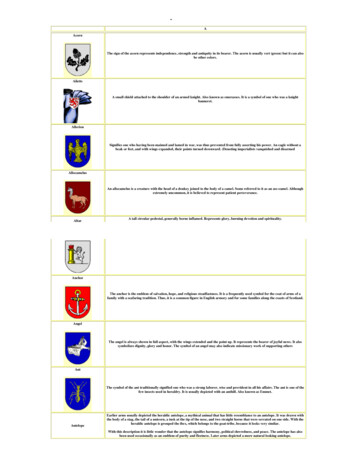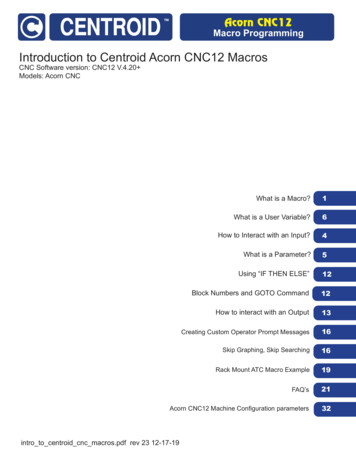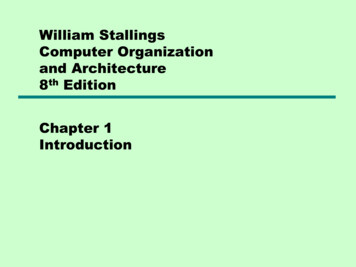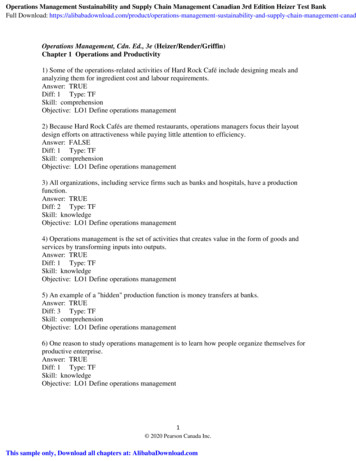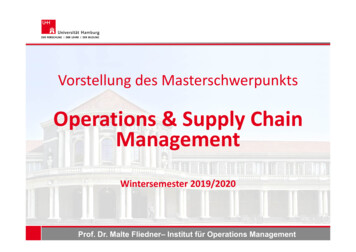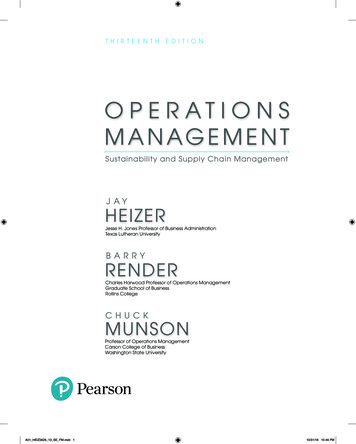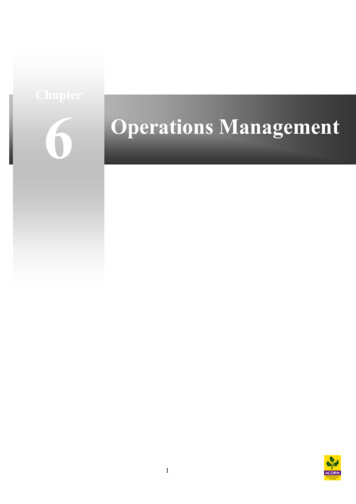
Transcription
Chapter6Operations Management1
6.1 Overview of operations managementOperations ManagementOperations management (OM) is any business function responsible for managing theprocess of making goods and services.Operations StrategyThe total pattern of decisions which shape the long-term capabilities of any type ofoperations and their contribution to the overall strategy, through the reconciliation of marketrequirements with operations resources.( Definition: Slack and Lewis)Operations management (OM) is any business function responsible for managing the processof making goods and services and without it there would be no products or services to sell tocustomers. It is any management function responsible for planning, controlling andcoordinating the necessary inputs (resources) such as technology, information, people,equipment, inventory etc. and managing the transformational processes of ‘making goods orservices’. Organisations heavily rely upon operational processes to produce effectiveproducts and efficiently deliver them on time and customers receiving services relative tobuying goods, will often participate more extensively in the creation and delivery of services‘more visibly’ seeing operations being performed.Operational management has a major impact on the cost of producing products or servicesand how well the products and services are produced and delivered. Operational functions(departments) are the transformational processes required to convert business inputs(resources) in ways that add value (utility) for customers, therefore higher customerwillingness to pay and profit margin. Operations management is critical to gainingcompetitive advantage (‘order winners’) for an organisation.Examples of operational functions within an organisation····Merchandising ‘where retail occurs, bricks or clicks’ e.g. store outlets or websites.Manufacturing, production or processing e.g. physical manufacturing andassembly.Customer support e.g. customer call centres, customer service and after salesservice, customer complaints and warranty (repair) departments.Warehousing, logistics and transport e.g. storage, transport and inventory control.The four Vs of operations strategyAccording to Slack, Chambers and Johnston the goal of any organisation is to make the mosteffective use of its operations while ensuring that its customers are satisfied with the quality,cost, availability and quantity of goods or services. The four Vs of operations according tothem can help all types of organisation make the most effective use of their operations.Organisations can make more effective use of their resources (inputs) to make products orservices (output) in a number of ways;·Volume e.g. this dimension is key to organisations like McDonalds, whereuniformity, standardisation, automation and routine are key to achieving highvolumes (mass production) of output and therefore low cost per unit. This2
dimension works best when operations make a single product or small range ofstandard products.·Variety e.g. this dimension could be key to financial services or even hairdressing, ineither case staff often have to produce a variety of different types of financial advicee.g. tax, insurance, pensions or investment, or in the case of a haircut e.g. hair dye,perm, trim or skinhead. This dimension requires more ‘functional flexibility’ (ormulti-skilled) staff and other resources in order to produce a ‘diversity of output(variety)’, otherwise a low cost model can be difficult to achieve.·Variation e.g. this dimension refers to the ‘degree of customisation’ to its productsor services that an organisation can offer to its customers, for example luxury housebuilding, holidays or cars, can often be tailored specific to unique requirements ofeach customer. Standard costing and therefore cost control becomes harder to achievewith this type of model because each product could be unique and specific to eachcustomer.·Visibility e.g. this dimension refers to the ‘customer’s ability to see and experience’operations as a process. This dimension is more critical to service organisationssuch as retail or hairdressing, in both cases physical evidence, people and processesare witnessed first-hand by the customer. Royal Mail customers can track and tracetheir parcels, which also supports the same principle.Operations strategy is therefore vital. If an organisation can offer certain unique featuresabout their products or services, then customers could be willing to pay extra for this and mayremain more loyal to the organisation. Product design incorporates factors such as aesthetics,reliability, durability, product functions and features, novelty, design, colour and even thecourtesy, enthusiasm and friendliness of staff involved in supporting customers can all makea massive difference to customer value and brand loyalty.Performance dimensions for product design····Quality e.g. Marks & Spencer, Thornton’s, BMW all are synonymous with the imageof high quality. Quality means ‘fitness for the purpose’, so characteristics includehow the product functions (what it does), robustness, reliability, taste or features ithas.Speed e.g. The AA or RAC could offer superior call out response times, Concordewhen it was first launched gave the fastest transatlantic flights, courier companies likeFedEx Express guarantee overnight global parcel delivery.Flexibility e.g. ability to increase or decrease production to meet customer demand,or offer a variety and variation in products or services. Multi-skilled staff andresources can help an organisation achieve greater flexibility and economies of scope(cost savings by using the same resource to make different products or services).Cost e.g. important if aiming to offer a product or service at the lowest possible price(cost leadership strategy). Cheap and cheerful products like supermarket ‘owneconomy brands’ or the ‘basic no frills service’ of Easy Jet and Ryan Air, oftenachieved by standardisation of products with inferior features or functions in order tokeep the cost of production very low.3
6.2 Porter’s value chain analysisA value chain is ‘the sequence of business activities by which in the perspective of the enduser, value is added to the products or services produced by an organisation’.(CIMA).Value chain analysis (VCA) is a position audit tool which examines the current and ‘internal’position of an organisation. It is ideal tool to examine holistically the operational processesof an organisation. According to Professor Michael Porter, an organisation receivesresources (inputs) from its environment and converts (processes) these into products orservices (outputs), in doing so it creates ‘added value’ (margin or profit) for the organisationand its customers.Porter grouped nine business processes or activities of an organisation into what he calledthe value chain activities classified as either primary or secondary activities. Each activityincurs cost but in combination with other activities will provide customer satisfaction andadded value. Profit margin is the value created when combining activities.·Primary activities are processes or activities directly involved in the provision of thegood or service the organisation makes or provides e.g. inbound logistics, operations,outbound logistics, marketing/sales and after sales service·Secondary or support activities support the primary activities by providingnecessary support and resources, but are not directly involved in the provision of thegood or service the organisation makes or provides e.g. infrastructure, human resourcemanagement (HRM), technology and procurement·Activities are business processes the organisation manages in order to ‘add value’e.g. the product or service should be worth more than its cost of the individual parts orresources required to make it, allowing profit margin to be oundLogisticsAfterMarketing Sales&ServiceSalesMarginPrimary Activities4
Inbound logisticsBusiness processes that receive, handle and store inputs (resources) e.g. warehousing,inventory control and inbound transport.OperationsBusiness processes which are ‘transformational’ and convert inputs to outputs e.g. staff,materials, machines, equipment etc. used to assemble the final product or service.Outbound logisticsBusiness processes which deliver the final product (output) when it leaves the organisatione.g. outbound storage and transportation of goods to the customer or another third partyintermediary within the supply chain.Marketing & SalesBusiness process of researching customer needs, targeting specific customers, selling tothem and designing an effective marketing strategy for the organisations products andservices.After sales serviceBusiness processes that support the product or service (output) when it has left theorganisation e.g. departments that deal with product returns, customer complaints, aftersales training and product support.ProcurementBusiness processes to manage and negotiate the acquisition of resources (inputs) for theother activities e.g. components, raw materials and equipment. Ensures resources requiredare in the right place at the right time and right cost e.g. purchasing departments.Technology developmentBusiness processes required for innovation, product design and testing or the invention ofnew products and processes e.g. product design or research and development (R&D)departments.Human resource management (HRM)Business process to procure and look after the organisations most valued asset ‘its staff’e.g. staff recruitment, selection, training, development, retention and reward. Staff are avital requirement for all activities.InfrastructureBusiness processes to support the whole of the value chain but not belonging to any of theother eight categories of activity above e.g. head office, legal, finance, IT, buildingsmaintenance, quality control, staff canteen.5
6.3 Business Process Re-engineering (BPR)BPRThe fundamental redesign of existing business processes to achieve improvements in criticalareas such as cost, speed, quality or service.Hammer & Champy (1993) defined the process of reengineering as "the fundamentalrethinking and radical redesign of business processes to achieve dramatic improvements incritical, contemporary measures of performance, such as cost, quality, service and speed."A business system, function or process takes inputs such as resources and processes(transforms) them in some way to achieve an output of some kind. Anything that hinders thisefficient and effective delivery should be reengineered. Re-engineering existing businessprocesses can shorten lead-times, improve customer service or add value to the product orservice being sold. Information technology is primarily viewed as the enabling factor todayfor BPR e.g. automation of processes, however, computerised processes do not necessarilymean re-engineering, it has to produce a better-desired outcome.Characteristics of BPR1. Fundamental rethinking2. Re-design of existing business processes3. Dramatic improvements in existing business processesBPR identifies and analyses existing processes in order to innovate them, it attempts torationalise, eliminate or add value to a process by redesigning and reassembling it to operateas efficiently and as effectively as possible.BPR programmes could include···Combining jobs e.g. breaking down functional specialisation for greater flexibility.Greater empowerment and training of staff to improve performance.Re-designing systems to rationalise and improve efficiency.Ford Motor CompanyFord in the 1980s employed a large number of staff for the purpose of matching goodsreceived notes to orders and then to invoices. The Pareto condition e.g. 80% time wastedreconciling 20% of the orders and invoices applied here. Through the use of BPRtechniques, Ford introduced a computerised system where orders were entered, any goodsreceived that did not match to orders input, were automatically rejected at the door andpayment refused. This simple yet effective re-design saved thousands of pounds throughreduction in headcount.6
Benefits of BPRüüüüüCompetitive advantage e.g. cost, lead time, efficiency.Added value to customers e.g. quality and satisfaction.Reduction in staff headcount and paper flow when automating.Improvement in staff morale and motivation when using new technology.Regular projects keep pace with new technology and change.The stages in a BPR exercise1.2.3.4.5.6.7.Identify processes to be re-engineered e.g. those suitable for innovationUnderstand, break down and analyse the processIdentify ‘change levers’ e.g. look at new or existing technology to improve itRationalise or eliminate process if it does not add valueRedesign process to operate in the most efficient cost effective wayReassemble, implement process and manage changeMonitor and review to ensure the expected benefits are realisedProcess innovationProcess innovation is more transformational or ‘step change’ for an organisation, processinnovation is radical change or large scale change to the operations or processes of anorganisation. Often this type of change involves major restructuring, reorganisation andcultural change often necessary, perhaps a completely new way of thinking. A good examplewould be e-commerce first introduced by an organisation as an entirely new medium forselling its products or services.Examples of process innovation···Henry Ford’s first use of the mass production line within the car industry.Lithography method used to manufacture microchips within the computer industry.Internet, barcodes and scanners within the retail industry.BPR contrasted with process innovationBPR fundamentally redesigns existing business processes.···Identifies and analyses existing processes to innovate.Rationalises or eliminates if it does not add value.Redesigns and reassembles existing processes to operate efficiently and effectively.Process innovation takes a process view of an organisation, as does BPR, but with theapplication of transformational innovation to a process, it creates an entirely new processesand therefore considered more radical than BPR.···Creates new processesMay involve cultural change and major restructuringGreater chance of adding value7
6.4 Process mappingProcess design is the activity of determining workflow, equipment and other resource needs,for a process (activity) to work effectively. Good process design typically uses flowchartingas a tool for a process to be improved, it is normally a good idea to first illustrate the processin order to undertand it, communicate this to others ‘visually’ and then work on itsimprovement. Process mapping is the use of flow charts or diagrams e.g. arrows, symbols andshapes in order to facilitate the understanding of a process. It is a tool which assists with goodprocess design. Each symbol in a process map is used to demonstrate the flow of a processfrom start to finish. There are many other flowchart symbols that can also be used, but moreimportantly flow charts will help to communicate understanding of a process.·Oval shapes or elongated circles signify the start or termination of a process.·Rectangles signify processes, instructions or actions.·Diamonds show decisions that need to be made.Benefits of process mappingü Management understanding of processes better when mapping is used.ü Supports other tools such as benchmarking, business process re-engineering and leanmanagement (or waste elimination) to achieve dramatic improvements in customersatisfaction or cost reduction.ü Worker understanding of where their roles and responsibilities are linked within aprocess and how this integrates with other processes.ü Diagrammatically can highlight process inefficiencies or lack of value and help focuson where improvement is needed.ü Can be used for structured ‘walk through’ testing to confirm logic of a process.ü Can be used to set up prototype designs for new processes.ü Step-by-step flow without being overwhelmed by the bigger picture.Mapping processes can be complex, long winded and awkward and getting everyone to agreewith what a new process ‘should be like’ may take many redrafts. Microsoft Visio is anexample of a ready-to-use software package for process mapping, which can be used tominimise work effort for professionally designing process maps.8
Work studyWork study means the systematic examination of methods or processes that carry outactivities, in order to improve the efficient and effective use of resources that support workflow. Work study can also help design standards of performance in order to monitor anactivity better. Work study could include examining a job in order to make it more efficientor time motion studies undertaken to determine standard performance for how long a job ordifferent elements of a process should take. Process mapping is a useful tool to support workstudies and so is BPR when trying to re-engineer work processes for better performance.6.5 Capacity planningCapacityThe maximum limit to the volume of a product or service an organisation can producewithin a given timescale and bound by its current constraints such as existing technology,resources and efficiency of business processes.The ability of an operation to perform and produce (capacity) is often quantified by usingproductivity, efficiency and utilisation measures.Terminology for capacity··Over capacity (spare capacity) means that resources e.g. staff, machines andequipment are not being fully utilised (‘idle’) and the organisation is not operating atfull capacity, there is insufficient demand for the organisations products.Under capacity (full capacity) means that customer demand is greater than themaximum capacity the organisation can make or sell e.g. full order book, customerqueuing and waiting lists.Forecasting demand can be complex and unreliable within uncertain environments today so abalance needs to be struck between capacity available and meeting customer expectations anddemand. If an organisation does not manage its operations effectively it may either be tyingup money unnecessarily e.g. idle labour or holding large inventory levels, or not able tosupply products or services flexibly enough to meet surges in customer demand during ‘peak’moments and therefore lose orders.Market forecasting methods for predicting demand levels····Survey or sample of buyer intentions ideally suited for short and medium-term salesforecasting, the results can be fairly accurate and realistic. A sample of customerscould be asked would you buy this product and in what quantity? This data can thenbe extrapolated from the sample taken to create a ‘population’ forecast of likelydemand.Composite of sales force opinions where human judgement is applied by sales staffwithin the organisation that have good understanding of customers, market demandand likely growth levels.Expert opinions industry experts or consultants and ‘what they say’, but this methodis often hampered by a lack of expertise available.Past-sales analysis projections (trend and forecasting models) using a mathematical9
··study of past (historical) performance e.g. high low method, time series, regressionanalysis, or scatter graphs. The major limitation of these methods is that pastperformance may not be a good indication of the future.Market test methods could include consumer trials and testing of new products orproduct features for consumers to give their direct and often qualitative opinions andfeedback to ascertain likely popularity. Testing provides valuable assistance indetermining future ‘potential’ for customer demand, providing the research is notflawed or poorly designed.Queuing theory e.g. a mathematical study of the formation of waiting lines or queues(electronic or physical), for when customer ‘arrivals’ occur at random intervals. Thetheory can produce several performance measures e.g. average waiting times, orexpected number of customers at certain times. Queuing theory is generallyconsidered a branch of operations management because the results can be used to planfor resources needed to provide a product or service. Examples include softwareintelligent agents to monitor call centre phone activity or direct (or CCTV) monitoringof physical customer queues in a supermarket. Often viewed as too mathematicallyrestrictive to be able to model all real world situations exactly on it.Queuing theory enables a series of performance measures to be monitored.ü Performance measures can be calculated to help improve operations. Ratios such asaverage waiting times can be monitored for the impact on customer satisfaction.ü Expected number of customers can be determined in advance for more effective staffand resource planning.ü Can be used to respond to variations in demand for products or services e.g.marketing promotion can help 'smooth' peaks and troughs in demand.ü Internal benchmarking e.g. ratios of different sales outlets compared to identify whereimprovement in customer throughput is required.Factors that influence capacity····Resources available e.g. quantity of labour and skills, quantity of machines and timesavailable. ‘Bottlenecks’ restrict an organisations resource capacity to supply.Flexibility from staff and other resources can help achieve quicker lead times.Physical space e.g. maximum seating in a stadium or restaurant, or maximumproduction space to manufacture goods.Efficiency and waste e.g. time taken to convert inputs (resources) into the product orservice (output). The minimisation of staff idle time (or other resources) and wastagelevels from inputs is vital to maximise efficiency, increase throughput and reducecost.Lead time (responsiveness) e.g. high set up time for production or long productioncycles can make supply very unresponsive (inelastic) to changes in customer demand.10
6.6 Achieving workforce flexibilityTypes of staff flexibility·····Functional flexibility (task flexibility or ‘multi-skilled’ employees) is achieved bybreaking down traditional occupational boundaries and specialisation. Manufacturingworkers for example may be required to take on other indirect tasks such as qualitycontrol, cleaning of work area, routine machine maintenance and learn newproduction processes and skills. This enables staff (or their skills) to be used moreflexibly by being moved around the organisation in order to save cost or coverabsenteeism. Functional flexibility can be achieved by staff secondments, trainingand job rotation to learn new skills.Financial flexibility is achieved by using performance related pay systems e.g. staffpaid per unit of product they make or sell, this helps achieve better cash-flowmanagement when production is slack. Financial flexibility converts staff cost fromfixed to variable therefore supporting better cash-flow management.Numerical flexibility enables a firm to rapidly adjust the number of staff it has tochanging levels of customer demand. This can be achieved by reducing permanentfull-time staff and recruiting instead more subcontractors, temps or part-time workers.Temporal flexibility can be achieved by varying the time of day or days in the weekan employee is willing to work e.g. time off in lieu after working longer shifts toaccommodate a surge in demand, or covering for other staff shifts at a moment’snotice. It can be achieved by staff contract terms or culturally accepted by staff.Location flexibility is to do with the ‘geographical mobility’ of the organisationsstaff such as the ability to move staff between offices, branches or outlets within otherparts of the country and even internationally. It can be achieved by staff contractterms or culturally accepted by staff.The flexible firm model proposed by John Atkinson, divides employees into threecategories: core, peripheral and external labour.The shamrock organisation proposed by Charles Handy, divides employees into threecategories: core, contractual and flexible labour.Both models explain how organisations can achieve greater flexibility.The “flexible firm”The concept of the “flexible firm” was proposed by John Atkinson, he recognised thatorganisations will require greater flexibility if they are to adapt swiftly and meet the everevolving market and competitive challenges they face. Greater workforce flexibility mayberequired due to uncertain market conditions or seasonal changes in demand, this helpsachieve greater cost-effectiveness for the organisation. The “flexible firm” model suggeststhat we can design flexible staff arrangements to proactively meet business needs. Forexample more numerical flexibility can be achieved by the use of peripheral workers (parttime or temporary staff) or external labour (freelancers, sub-contractors, or self-employed).Core workers (full-time permanent employees) are not as easy to reduce in number whenbusiness contraction is required however can provide greater functional flexibility.11
The 'Shamrock Organisation'Charles Handy used the 'Shamrock Organisation' to apply a model to workforce flexibility.The three leaves of a shamrock are used to symbolise an organisations human resources.···The inner core of permanent key employees who keep the company operating anddeveloping e.g. full-time professional staff.The contractual fringe (or ‘external’ labour) e.g. self-employed, subcontractors oroutsourcers who are engaged to provide services as and when needed by theorganisation.The flexible (or peripheral labour) workforce e.g. temporary, casual or part-timeemployees on short-term contracts and like the contractual fringe taken on as andwhen needed by the organisation.The three parts of the shamrock (types of labour) all have advantages and disadvantages. Theinner core are often well paid with superior reward and recognition packages but often dowork by comparison that is stressful, work longer hours (sometimes unpaid) and are morecommitted. The flexible workforce such as temp or casual workers have less job security andoffer greater numerical flexibility for the organisation, however can work out more expensivein the short-term. The contractual fringe (or external labour) also offer numerical flexibilityand more effective cost control, however being ‘external’ and often with no sense ofbelonging to the organisation, may not care very much about it or have their own priorities.The inner core and contractual fringe can often perform identical jobs, side by side, often ondifferent wage or recognition packages.Achieving greater flexibility····Increased use of outsourcing will according to Handy attempt to shrink theorganisations ‘inner core’ leaf (downsize) and enlarge its ‘contractual fringe’ leaf as abasis of improving both numerical and financial flexibility.Short-term staff contracts can achieve numerical flexibility.Use of performance related pay systems can achieve a lower composite of fixed staffwages and salaries and achieve greater financial flexibility.Job enlargement, multi skilling and empowerment of the organisations full-time andpart-time staff can achieve greater functional flexibility.12
6.7 Capacity planning and controlCapacity planning and control is about how an organisation responds to variations in demandfor its products in order to balance capacity (supply) with demand by its customers.Level capacity strategyThe organisation manufactures (produces or makes) its products at a ‘constant rate’ ofoutput, ignoring any fluctuation in customer demand levels. This means ‘stockpiling’during periods when customer demand is low and then the running down of inventory levelsto fulfil customer demand during peak times e.g. when demand outstrips capacity.ü Full utilisation of operational resources at all times.ü Efficient mass production levels can be held at a constant rate.ü Lowers average unit cost of products e.g. mass production drives down cost.High risk of stock obsolescence if customer preferences or needs change.High cost in service industries when assets are under-utilised e.g. idle in off-peak.Chase demand strategiesThe opposite to a level capacity strategy. The organisation continually ‘chases’ customerdemand and extends or contracts its supply (output or capacity) to match existing customerdemand levels e.g. a Just In Time (JIT) system, or ‘pull demand strategy’. This strategy willrequire flexible utilisation of operational resources e.g. constant adjustment to resource andworkforce capacity using methods such as ‘quick hiring and then lay-offs’ using part-timeand casual labour, or the use of overtime working from permanent staff during moments of‘peak demand’.ü Flexible utilisation of resources for better economies of scope e.g. cost savings byutilising the ‘same staff or machines’ to make a ‘variety’ or ‘variation’ of products.ü Minimisation of inventory levels e.g. aim of JIT is ‘stockless production’,so materials or finished goods are ordered or made only when there is a customerorder, less cash-flow is tied up within inventory when resources are under-utilised.Over reliance on flexible staff during ‘peak’ periods of time e.g. overtime, temps orsub-contractors can hinder responsiveness to surges in customer demand.High risk of disruption given the organisation does not store inventory, so it may failto deliver on time and respond to surges in customer demand.13
Demand management strategiesThe aim of this strategy is to influence customer demand levels, in order to match demandcloser to the organisations most ‘efficient’ operating capacity. It is a strategy to ‘smoothout’ customer demand during ‘peak’ and ‘off peak’ periods. Continual adjustments aremade to the ‘marketing mix’ of products to influence demand levels such as product pricingadjustment or promotional activities to help 'smooth' demand peaks and troughs.ü Helps maintain full capacity to avoid layoffs or under-utilised resources.ü Maintains a constant level o
Operations Management Operations management (OM) is any business function responsible for managing the process of making goods and services. Operations Strategy The total pattern of decisions which shape the long-term capabilities of any type of operations and their contribution to the overall

